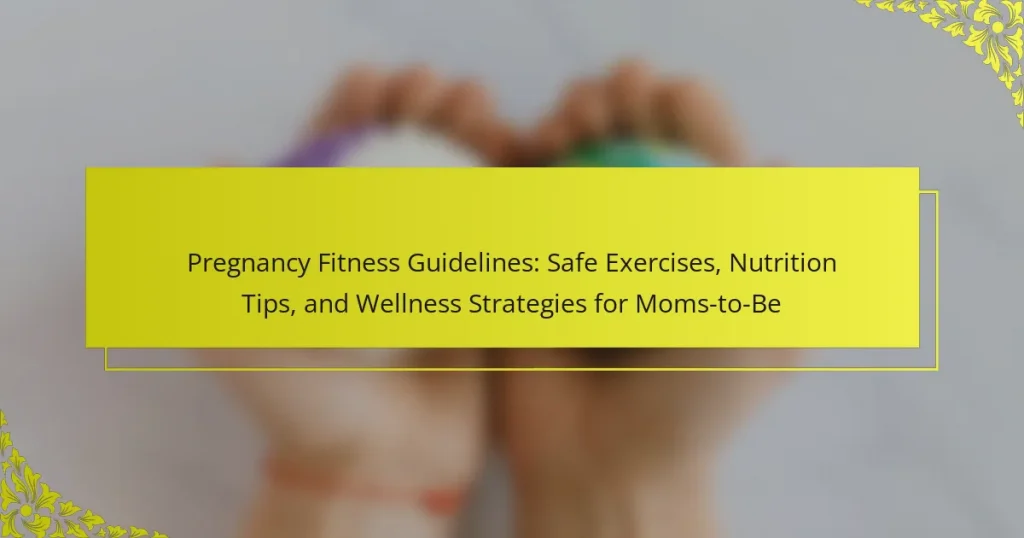Pregnancy fitness is essential for the health of both mother and baby. This article covers safe exercises, including low-impact activities, nutrition tips focusing on essential nutrients, and wellness strategies to manage hydration and stress. It also addresses unique challenges pregnant women face and emphasizes the importance of consulting healthcare providers for tailored guidance.

What are the essential guidelines for pregnancy fitness?
Engaging in pregnancy fitness is crucial for the health of both mother and baby. Essential guidelines include safe exercises, balanced nutrition, and wellness strategies.
Safe exercises should focus on low-impact activities like walking, swimming, and prenatal yoga. These activities enhance cardiovascular health and flexibility while minimizing injury risk. Nutrition tips emphasize consuming a variety of nutrient-rich foods, including fruits, vegetables, whole grains, and lean proteins, to support fetal development.
Wellness strategies involve prioritizing hydration, managing stress through relaxation techniques, and ensuring adequate sleep. Additionally, consulting a healthcare provider before starting any fitness regimen is vital to tailor activities to individual health needs.
How does exercise benefit pregnant women?
Regular exercise benefits pregnant women by improving physical health and emotional well-being. It enhances cardiovascular fitness, reduces back pain, and improves sleep quality. Exercise can also help manage weight gain during pregnancy and reduce the risk of gestational diabetes. Engaging in safe activities, like walking or swimming, promotes overall wellness. Studies show that active pregnant women experience lower rates of postpartum depression, highlighting the unique emotional benefits of exercise.
What types of exercises are safe during pregnancy?
Low-impact exercises are generally safe during pregnancy. Walking, swimming, and stationary cycling are excellent options. Strength training with light weights can also be beneficial. Always consult a healthcare provider before starting any exercise regimen.
What are the best low-impact exercises for moms-to-be?
Walking, swimming, and prenatal yoga are the best low-impact exercises for moms-to-be. These activities enhance cardiovascular health, improve flexibility, and reduce stress. Walking is easily accessible and can be tailored to individual fitness levels. Swimming provides buoyancy, minimizing strain on joints while offering a full-body workout. Prenatal yoga focuses on breathing and relaxation techniques, promoting mental well-being. Engaging in these exercises regularly can lead to healthier pregnancies and better labour experiences.
How can strength training be adapted for pregnancy?
Strength training can be safely adapted for pregnancy by focusing on moderate intensity, proper technique, and specific exercises. Prioritize bodyweight movements, resistance bands, and light weights to enhance strength without straining.
Maintain a routine that includes exercises targeting major muscle groups, such as squats, lunges, and modified push-ups. Aim for 150 minutes of moderate aerobic activity weekly, incorporating strength training at least twice a week.
Always consult with a healthcare provider before starting or modifying a fitness regimen during pregnancy. This ensures the chosen activities align with individual health needs and the pregnancy stage.
What role does flexibility training play in pregnancy fitness?
Flexibility training is essential in pregnancy fitness as it enhances mobility and reduces discomfort. It helps alleviate back pain and prepares the body for labour by promoting muscle elasticity. Regular stretching can improve posture and decrease the risk of injury during pregnancy. Additionally, it fosters relaxation, which is beneficial for mental well-being. Engaging in safe flexibility exercises can also aid in recovery postpartum, making it a valuable component of a comprehensive fitness routine for moms-to-be.
What nutritional considerations should pregnant women keep in mind?
Pregnant women should focus on balanced nutrition, ensuring adequate intake of essential vitamins and minerals. Key considerations include increased folic acid for fetal development, iron to support blood volume, and calcium for bone health. Incorporating whole grains, lean proteins, fruits, and vegetables is crucial. Staying hydrated and limiting caffeine and processed foods further supports a healthy pregnancy.
Which nutrients are crucial for pregnancy health?
Folic acid, iron, calcium, and DHA are crucial nutrients for pregnancy health. Folic acid prevents neural tube defects, while iron supports increased blood volume. Calcium is essential for fetal bone development, and DHA contributes to brain health. A balanced diet rich in these nutrients is vital for both mother and baby.
How can hydration impact pregnancy fitness?
Hydration significantly impacts pregnancy fitness by maintaining energy levels and supporting bodily functions. Adequate fluid intake helps prevent dehydration, which can lead to fatigue and decreased exercise performance. Pregnant women should aim for at least 10 cups of water daily, adjusting based on activity levels and climate. Staying hydrated supports nutrient absorption and helps manage common pregnancy discomforts, such as swelling and constipation.
What wellness strategies support fitness during pregnancy?
Engaging in safe exercises, maintaining a balanced diet, and managing stress are key wellness strategies for fitness during pregnancy. Low-impact activities like walking, swimming, and prenatal yoga enhance physical health without risking injury. Nutritional guidelines emphasize whole foods, adequate hydration, and prenatal vitamins to support both mother and baby. Stress management techniques such as mindfulness and breathing exercises promote emotional well-being, which is essential during this transformative period.
How can prenatal yoga enhance physical and mental well-being?
Prenatal yoga enhances physical and mental well-being by improving flexibility, reducing stress, and promoting relaxation. It helps alleviate common pregnancy discomforts such as back pain and swelling. Regular practice encourages mindfulness, fostering a deeper connection between the mother and baby. Research indicates that prenatal yoga can lead to improved sleep quality and reduced anxiety levels, contributing to overall wellness during pregnancy.
What are effective stress management techniques for pregnant women?
Effective stress management techniques for pregnant women include practicing mindfulness, engaging in regular physical activity, and maintaining a balanced diet. Mindfulness techniques such as meditation can reduce anxiety and promote relaxation. Safe exercises like walking or prenatal yoga enhance physical well-being and alleviate stress. A nutritious diet rich in fruits, vegetables, and whole grains supports overall health and emotional stability. Additionally, establishing a strong support system with family and friends can further enhance emotional resilience during pregnancy.

What unique challenges do pregnant women face in fitness?
Pregnant women face unique challenges in fitness, including physical limitations, hormonal changes, and emotional fluctuations. These factors can affect exercise routines and overall wellness.
Physical limitations arise as pregnancy progresses, making certain movements difficult or uncomfortable. Hormonal changes can lead to increased fatigue and altered balance, impacting workout intensity and safety. Emotional fluctuations may cause motivation dips, making consistent exercise challenging.
Additionally, pregnant women must navigate guidelines around safe exercises. Activities such as high-impact sports and heavy lifting are generally discouraged. Instead, low-impact options like swimming and walking are recommended to promote fitness without risk.
Nutrition plays a crucial role in supporting fitness during pregnancy. Adequate intake of essential nutrients, such as folic acid and iron, supports both maternal health and fetal development. Balancing calorie intake with physical activity is vital to maintain a healthy weight.
How can physical discomfort be managed during exercise?
To manage physical discomfort during exercise, pregnant women should focus on proper techniques and modifications. Listening to the body is crucial; if discomfort arises, adjusting intensity or taking breaks can help. Staying hydrated and wearing supportive gear also alleviates discomfort. Engaging in low-impact activities, such as swimming or walking, reduces strain while providing effective workouts. Consulting healthcare providers ensures exercises align with individual health needs, making workouts safer and more enjoyable.
What modifications are necessary for different trimesters?
Modifications for pregnancy fitness vary by trimester due to physiological changes. In the first trimester, focus on low-impact exercises like walking and swimming, while avoiding high-risk activities. The second trimester allows for increased intensity, incorporating strength training and flexibility exercises. In the third trimester, prioritize gentle activities, such as prenatal yoga, and maintain hydration. Adjust nutrition to meet increased caloric needs throughout all trimesters, ensuring a balanced intake of vitamins and minerals.

What rare but important considerations exist for pregnancy fitness?
Pregnancy fitness requires careful consideration of unique factors. Rare but important considerations include individual health conditions, the need for tailored exercise regimens, and hydration levels. Women with conditions like gestational diabetes or hypertension should consult healthcare providers for personalized guidance. Additionally, engaging in low-impact activities, such as swimming or walking, is advisable. Maintaining proper hydration is crucial, as dehydration can lead to complications. These factors ensure a safe and effective fitness journey for moms-to-be.
How does a high-risk pregnancy affect fitness options?
A high-risk pregnancy significantly limits fitness options for expectant mothers. Safety becomes the primary concern, necessitating tailored exercise plans. Low-impact activities like walking and swimming are often recommended, while high-risk conditions may restrict exercises that involve balance or abdominal strain. Consulting healthcare providers ensures that fitness routines align with individual health needs. Regular monitoring and adjustments to the fitness plan are crucial for maintaining both maternal and fetal health.
What specialized programs are available for pregnancy fitness?
Specialized programs for pregnancy fitness include prenatal yoga, water aerobics, and strength training classes tailored for expecting mothers. These programs focus on safe exercises, promoting flexibility, strength, and overall wellness. Many are designed to accommodate various fitness levels, ensuring a supportive environment for moms-to-be. Programs often emphasize core stability, pelvic floor strength, and relaxation techniques, contributing to a healthy pregnancy experience.

What are the best practices for maintaining fitness postpartum?
To maintain fitness postpartum, prioritize gradual physical activity, balanced nutrition, and mental wellness. Start with low-impact exercises like walking or pelvic floor workouts. Incorporate strength training after medical clearance. Focus on whole foods, hydration, and adequate sleep to support recovery. Engage in activities that promote mental health, such as yoga or mindfulness practices. Regular check-ins with a healthcare provider ensure safe progress.
How can new moms safely return to exercise after childbirth?
New moms can safely return to exercise after childbirth by starting with gentle activities and gradually increasing intensity. Focus on pelvic floor exercises and low-impact workouts like walking or swimming. Consult a healthcare provider before beginning any routine. Aim for at least 150 minutes of moderate aerobic activity weekly. Prioritize core strengthening and flexibility to support recovery.
What common mistakes should be avoided in postpartum fitness?
To avoid common mistakes in postpartum fitness, prioritize gradual progression, proper form, and listening to your body. Many new mothers rush into intense workouts, risking injury. Focus on core strengthening and pelvic floor exercises first. Additionally, consult healthcare providers for personalized guidance and avoid high-impact activities until cleared.
What expert insights can enhance pregnancy fitness routines?
Expert insights can significantly enhance pregnancy fitness routines by focusing on tailored exercises, balanced nutrition, and holistic wellness strategies. Incorporating low-impact activities, such as swimming and prenatal yoga, promotes cardiovascular health and flexibility while minimizing injury risk. Nutrition should prioritize whole foods, rich in essential vitamins and minerals, to support both maternal and fetal health. Regular consultation with healthcare providers ensures that fitness plans align with individual health conditions, adapting as the pregnancy progresses. Mindfulness practices, like meditation, can also improve mental well-being, reducing stress and anxiety during this transformative period.




